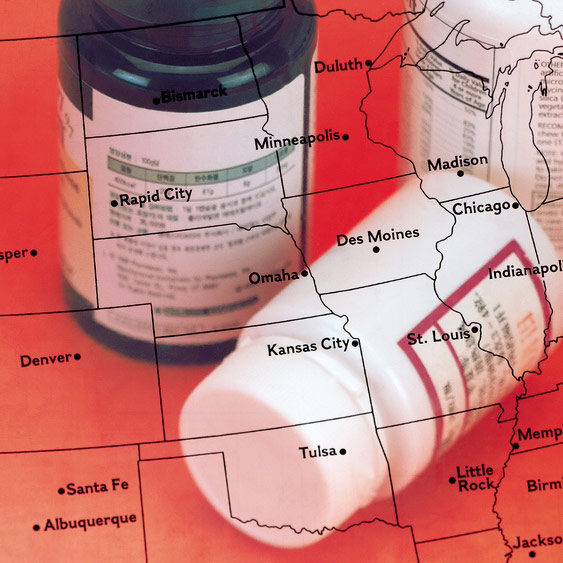
WEDNESDAY, April 11 (HealthDay News) — The U.S. Food and Drug Administration on Wednesday called on food producers, drug companies and veterinarians to help limit the use of antibiotics in farm animals.
The practice of mixing antibiotics in animal feed to make livestock, pigs and chickens gain weight and become more resistant to disease has been criticized for years in many quarters. Health experts contend that this overuse of antibiotics has led to an increase of germs — such as staph — that are growing increasingly resistant to antibiotics, threatening human health.
The FDA said it was issuing three documents to help veterinarians, farmers and animal producers use medically important antibiotics “judiciously” by limiting their use only to combat diseases and other health problems in animals. Under this “voluntary” initiative, certain antibiotics would not be used for so-called “production” purposes, which include enhancing growth or improving the effectiveness of animal feed, the agency said in a news release.
These antibiotics would still be available to prevent, control or treat illnesses in food-producing animals under the supervision of a veterinarian, the agency said.
“We know that the widespread use of antibiotics can contribute to antimicrobial resistance, which has public health consequences,” Michael Taylor, the FDA’s deputy commissioner for foods, said during a noon press briefing. “We know that the use of medically important drugs for production purposes in food-producing animals is a contributing factor.”
The FDA is proposing a three-year voluntary plan to change how antibiotics are labeled and used in farm animals. The agency hopes these steps will help preserve the effectiveness of these drugs for people.
The FDA said it decided at this time to make the changes voluntary, not mandatory.
“With the willingness of drug companies and others in the animal-production industry to collaborate in implementing our strategy, we can make changes more quickly than if we had to rely on a cumbersome regulatory process,” Taylor said. “Working together is how we will get results in a timely manner.”
But, if after three years, progress is lagging, then the FDA will consider tougher measures, he said.
The three documents, or plans, released by the FDA Wednesday are designed to help farmers, animal producers and veterinarians to use antibiotics in farm animals only to treat diseases.
The plans will ensure that certain antibiotics aren’t used to enhance growth or improve feed efficiency in animals. These antibiotics could still be used to “prevent, control or treat illnesses in food-producing animals under the supervision of a veterinarian,” the FDA said in a news release.
According to the FDA, the three documents being issued include guidelines for industry to assist in phasing out the use of antibiotics and increasing the oversight by veterinarians. The second document is a proposal to help drug companies phase out recommendations on using antibiotics for farm animals. And the third proposal outlines how veterinarians can use animal drugs in feed.
The U.S. Department of Agriculture is also involved with the new initiative.
Dr. John Clifford, chief veterinary medical officer for the U.S. Department of Agriculture, said in the news release: “USDA worked with the FDA to ensure that the voices of livestock producers across the country were taken into account, and we will continue to collaborate with the FDA, the American Veterinary Medical Association and livestock groups to ensure that the appropriate services are available to help make this transition.”
Commenting on the changes, Dr. David Katz, director of the Yale University School of Medicine’s Prevention Research Center, said that “antimicrobial resistance is among the scariest trends in modern public health.”
“We are in a race with germs that can cause infection and death, and when new kinds of resistance emerge, the germs get out ahead of us. The threat of serious infections we simply don’t have drugs to treat is very realistic,” he said.
While most people think antibiotic use by people is the major cause of such resistance, widespread use of the drugs in the raising of feed animals is probably an even bigger problem, Katz said.
“FDA guidance intended to reduce use of antibiotics in animal husbandry is thus important, timely, and very welcome. But, the new guidance is voluntary,” he noted. “The real measure of this initiative will be how widely and rapidly it is applied.”
Public health advocates are skeptical about asking drug makers to voluntarily restrict use of their products.
“The FDA is asking the public health community and those suffering from diseases whose antibiotic treatment has been compromised to simply trust them, and to trust the voluntary plan and the cooperation of the pharmaceutical industry to bring about needed change,” Richard Wood, chairman of Keep Antibiotics Working, said in a news release. “This is not about trust. This is a question of whether or not the FDA has fulfilled its mandate of protecting public health.”
More information
To learn more about antibiotic resistance, visit the U.S. Centers for Disease Control and Prevention.

